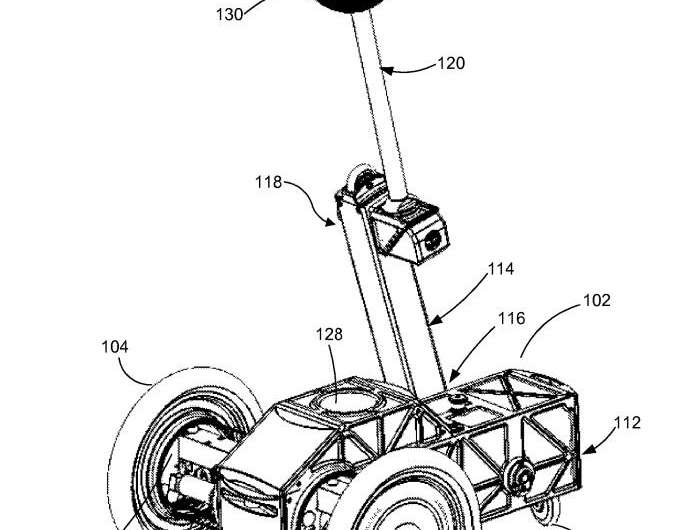March 8, 2018 weblog
Facebook patent is about robot that transitions from three-wheeled to two-wheeled mode

Tech watchers are talking about Facebook's patent for a Self-Balancing Robot, first filed in 2015 and dated this year on March 6.
The patent is from the U.S. Patent and Trademark Office (USPTO). Scott C. Wiley is named as the inventor.
Brad Bennett, MobileSyrup, said Facebook patented "a design for a self-balancing robot that transitions from three wheels to a standing two-wheeled position."
The design seeks to provide load-carrying capabilities.
This is yet another idea of how simple transporters with wheels can take on added features that place them in the smart zones.
You may have seen this month's report of a Segway Robotics launch on Indiegogo for a two-wheeler that also makes a mark in its "transition" nature, this time transforming from simple transporter into a sidekick with screen, camera and voice capabilities. The latter was designed to take pictures, follow you around and tote your packages home when not in simple transport mode of giving the owner a ride.
Bennett though made a case for why Facebook's concept is different. "Companies like Segway and 90fun have had moderate success trying to create two-wheeled robots that can carry things, but Facebook's tactic of adding another wheel for stability could be the breakthrough needed to make this use case work."
The concept evokes a telepresence robot, complete with a screen, camera and microphone.
Jason Murdock, Newsweek: "If the drawings prove accurate, it will come equipped with a camera and microphone, a rotatable 'main arm' and a set of wheels to help it zoom around." He said it could have a "storage region or a cargo support to carry items."
Murdock thought it looked "somewhere between a Segway, a Dalek and a dainty teleprompter."
Dom Galeon in Futurism called it a "futuristic personal cameraman."
Galeon discussed the telepresence thought.
"Telepresence robots, which seem to be the inspiration behind Facebook's new personal photographer, are essentially videoconferencing screens mounted on moving bases. Businessmen use these robots to remotely attend meetings or galas, projecting their faces on the screen and interacting with people as the robot perambulates around the room."
So, what do we know so far. It can roam around on two or three wheels, and it has rotating arms. It sports a display, camera, microphones and a speaker. Sites got busy taking stabs at what, if this patent ever advanced to product stage, kind of role it would serve: a mobile transporter with a screen for video conferencing? A telepresence robot?
Alphr was honest in that it freely admitted Facebook filed a patent "for a roaming Segway-style robot and we have no idea what it's playing at."
"Why is Facebook considering branching out into hardware in this way," asked Victoria Woollaston in Alphr, " and what value would the robot add to the social network and its other interests?"
One of its musings, however, was on the telepresence topic. "It could even be an alternative to current 'telepresence' robots that let people send machines to meetings on their behalf."
A robot in the home could also be used to autonomously take photos and videos for Facebook's content sharing platforms.
So, does Facebook via the robot want to leverage a photo-taking opportunity? Futurism was one of several sites raising the inevitable topic of privacy in all this: Galeon said "having a robot that follows you around can be quite disconcerting." He also remarked, "Last we checked, nobody wants a personal bot-parazzi."
Here's another thought: According to a CNN Wire report, Christopher Atkeson, a robotics professor at Carnegie Mellon University, envisioned multiple Facebook robots used to deliver a Facebook Live broadcast of an amateur sporting event.
CNET's Leslie Katz covered several potential bases including teleconferencing: "...drawings and detailed description of the little guy suggest Facebook could be looking to expand its videoconferencing capabilities with a device that adds a more human touch to long-distance electronic communications."
More information: Self-balancing robot, United States Patent, 9,908,573. (PDF)
Abstract
Technology is provided for a self-balancing robot that transitions from a three-wheeled mode to a two-wheeled self-balancing mode. The robot includes a body and a pair of drive wheels located at a first end portion of the body. Each drive wheel is coupled to a drive assembly operative to propel the robot along a surface. A third wheel is located on the body at a second end portion opposite the first end portion. A main arm is coupled to the body, wherein the main arm is rotatable to confront the surface and lift the third wheel away from the surface, thereby standing the body up onto the pair of drive wheels in preparation for self-balancing.
© 2018 Tech Xplore




















